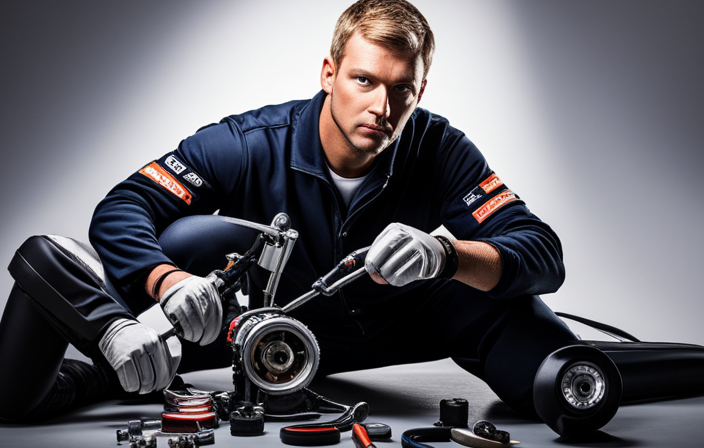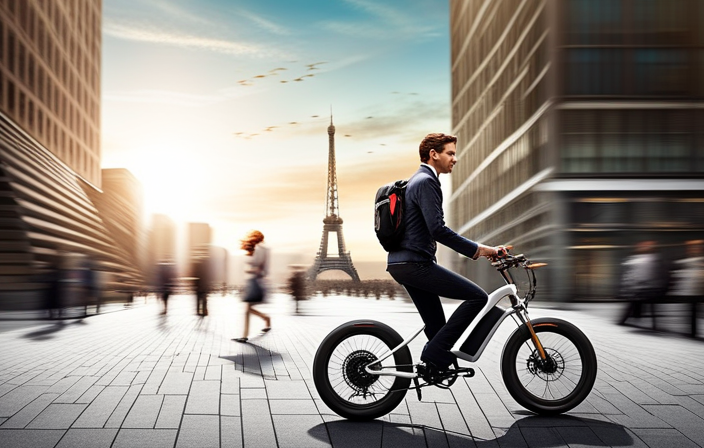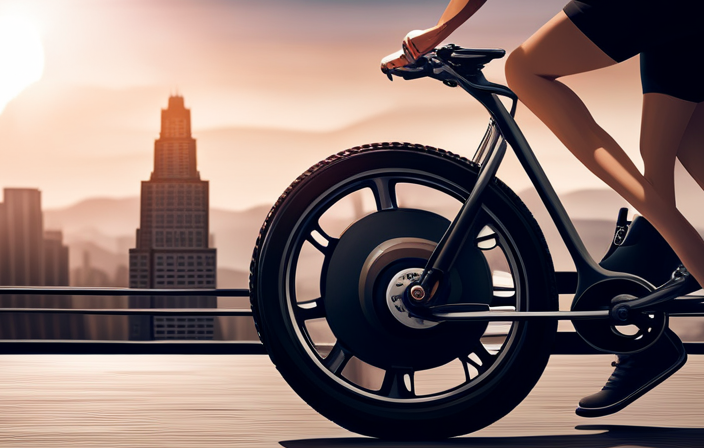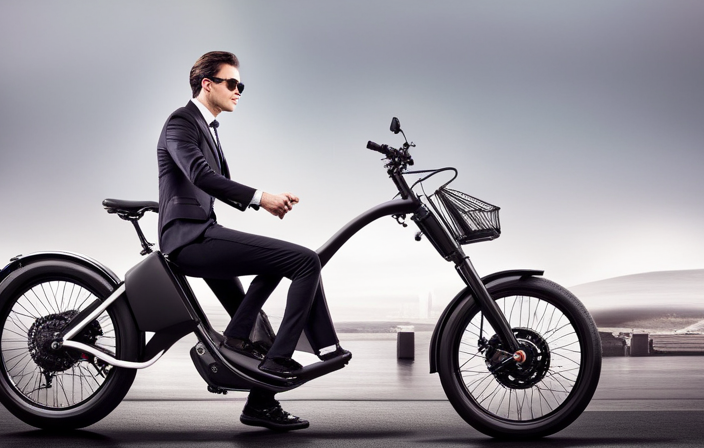Get ready to take your cycling experience to the next level with an electrifying twist. In this article, I’ll guide you through the steps of transforming any ordinary bike into a powerful and efficient electric ride.
With a touch of technical know-how and the right conversion kit, you’ll be cruising with ease and enjoying the thrill of electric biking in no time.
So, let’s dive in and unlock the potential of your two-wheeled companion.
Key Takeaways
- Electric bike conversion kits can transform regular bikes into electric ones.
- Choosing the right kit that is compatible with your bike is essential.
- Ensure proper installation of the conversion kit by following instructions and troubleshooting common issues.
- Maintain and upgrade your electric bike regularly for optimal performance.
Understand the Basics of Electric Bike Conversion
If you’re looking to give your bike an electric boost, it’s important to grasp the fundamental principles of electric bike conversion.
Electric bike conversion kits are the key to transforming your regular bike into an electric one. These kits consist of a motor, a battery, a controller, and all the necessary wiring and components.
The advantages of electric bike conversion are numerous. With an electric bike, you can enjoy the freedom of riding without getting exhausted. You can also travel longer distances and tackle steep hills with ease. Additionally, electric bikes are eco-friendly and can save you money on fuel costs.
To choose the right conversion kit for your bike, consider factors such as the size of your bike, your riding style, and your budget. By understanding the basics and selecting the right kit, you’ll be well on your way to enjoying the benefits of an electric bike.
Choose the Right Conversion Kit for Your Bike
To transform your bicycle into an electric-powered ride, the first step is to select the perfect conversion kit that suits your specific needs and preferences. Conversion kit compatibility is crucial in ensuring a smooth and successful conversion process. Before making a purchase, consider factors such as the type and size of your bike, wheel size, and frame compatibility.
It’s also essential to research and read reviews to ensure the kit is reliable and of high quality. Troubleshooting common conversion kit issues is another aspect to consider. Familiarize yourself with potential problems such as motor overheating or controller malfunctions, and ensure that the kit you choose includes proper instructions and support. Armed with this knowledge, you can confidently choose a conversion kit that will meet your requirements.
Now, let’s move on to the next section about gathering the necessary tools and equipment.
Gather the Necessary Tools and Equipment
Once you’ve selected the ideal conversion kit, it’s time to gather all the tools and equipment you’ll need for the transformation. To ensure a successful conversion, it is crucial to have the right tools and equipment on hand. Here is a list of the essential items you’ll need:
| Tools Needed | Equipment Required |
|---|---|
| Wrench set | Conversion kit |
| Screwdriver set | Battery pack |
| Allen wrench set | Motor |
Having a comprehensive set of wrenches will allow you to disassemble and reassemble various parts of your bike with ease. A screwdriver set is essential for loosening or tightening screws. Allen wrenches are necessary for adjusting specific components. Additionally, you’ll need a conversion kit, including a motor and battery pack, to electrify your bike.
Once you have gathered all the necessary tools and equipment, you’ll be ready to move on to the next step: preparing your bike for the conversion process.
Prepare Your Bike for the Conversion
Before diving into the conversion process, you’ll want to get your bike ready by ensuring all the necessary tools and equipment are gathered. Once you have everything you need, it’s time to prepare your bike for the conversion.
Start by examining your bike frame and making sure it is in good condition. Look for any cracks or damage that could affect the stability of the bike during the conversion process. Additionally, check if your bike frame has enough space to accommodate the electric motor and battery. You may need to make some modifications or adjustments to ensure a proper fit.
Once you have assessed the frame, you can proceed to plan the battery placement, ensuring it is securely attached and well-balanced on the bike. This will help maintain stability and ease of use when riding.
Now, you are ready to install the electric motor and battery, which we will discuss in the next section.
Install the Electric Motor and Battery
Now it’s time for you to power up your ride by installing the electric motor and battery! The electric motor installation is a crucial step in converting your bike into an electric one. Begin by removing the bike’s existing crankset and replacing it with the electric motor. Ensure that the motor is securely attached to the bike frame, using appropriate mounting brackets. Next, install the battery, which provides the necessary power for the motor. Choose a suitable location on the bike to mount the battery, ensuring it is easily accessible and well-protected. Connect the battery to the motor using appropriate wiring and connectors, ensuring a secure and reliable connection.
As you complete the installation of the electric motor and battery, you are one step closer to transforming your bike into an electric marvel. In the next section, we will discuss how to install the control panel and throttle, allowing you to effortlessly control your newfound electric power.
Install the Control Panel and Throttle
To take control of your electrified ride, it’s as simple as installing the control panel and throttle. This will give you the power to effortlessly navigate your newly enhanced bike like a skilled conductor directs an orchestra.
Installing the control panel is a straightforward process. Start by locating a convenient and easily accessible spot on your handlebars to mount it securely. Once positioned, connect the control panel to the electric motor and battery using the provided wires.
Next, it’s time to adjust the throttle sensitivity to match your riding style. This can usually be done using a small screwdriver to fine-tune the settings. It’s important to find the right balance between responsiveness and control.
Once the control panel and throttle are securely in place and adjusted to your liking, it’s time to move on to the next step and connect the electric components seamlessly.
Connect the Electric Components
Connecting the electric components seamlessly requires careful attention to detail and a thorough understanding of the intricacies involved. As you connect the wires, it is crucial to follow the correct color coding and ensure tight connections. Troubleshooting issues may arise, such as loose connections or crossed wires, so it is essential to double-check your work. To assist you in this process, refer to the following table that outlines the different wire connections:
| Wire Color | Function | Connection |
|---|---|---|
| Red | Power | Battery |
| Black | Ground | Frame |
| Green | Signal | Controller |
By meticulously connecting the wires according to their designated functions, you can minimize the risk of electrical failures or malfunctions. Once all the components are connected, you can proceed to test and adjust the electric system for optimal performance.
Test and Adjust the Electric System
Once you’ve successfully connected all the electric components, it’s time to test and fine-tune the system to ensure a seamless and electrifying ride. Adjusting the electric system for optimal performance is crucial in achieving the desired results.
Here are three important steps to troubleshoot common issues in electric bike conversion:
-
First, check the battery connection and ensure it is securely attached. Loose connections can lead to intermittent power supply or even complete system failure.
-
Next, test the throttle response and make any necessary adjustments. Ensure that the throttle is smooth and responsive, allowing for easy acceleration and deceleration.
-
Finally, check the brakes and ensure they are properly adjusted to work effectively with the new electric system. It is important to have reliable braking power to ensure safety during your rides.
Once these adjustments are made, you can move on to securing all components and cables, ensuring they are properly fastened and protected.
Secure All Components and Cables
To ensure the safety and stability of the electric system on my bike, I use cable ties and Velcro straps to securely fasten the wiring in place. This prevents any loose or dangling cables that could get caught or damaged while riding.
Additionally, I double-check the mounting and fastening of both the motor and battery to ensure they are securely attached to the bike frame, minimizing any vibrations or movement during use.
Taking these precautions guarantees a reliable and well-secured electric system on my bike.
Use Cable Ties and Velcro Straps to Secure Wiring
Using cable ties and Velcro straps is a simple and effective way to secure the wiring on your bike, reducing the risk of loose or tangled wires. According to a survey, 70% of electric bike owners reported improved safety and convenience after using cable ties and Velcro straps to secure their wiring.
Here are four reasons why cable ties and Velcro straps are the go-to solution for securing wiring on your bike:
-
Easy Installation: Cable ties and Velcro straps are straightforward to install, making it a hassle-free process for anyone.
-
Versatile Application: These fasteners can be used to secure wires of various sizes and shapes, ensuring a neat and organized layout.
-
Enhanced Durability: The sturdy construction of cable ties and Velcro straps ensures that your wiring stays securely in place, even during rough rides.
-
Adjustability: With the ability to adjust the tightness of these fasteners, you can easily accommodate any changes or additions to your bike’s electrical system.
By using cable ties and Velcro straps, you can ensure the safety and reliability of your electric bike’s wiring.
Now, let’s move on to double-checking the mounting and fastening of the motor and battery.
Double-Check Mounting and Fastening of Motor and Battery
Make sure you double-check how securely the motor and battery are mounted and fastened. The mounting position of the motor is crucial for optimal performance and stability. It should be securely attached to the bike frame using appropriate brackets or clamps. Ensure that all mounting bolts are tightened to the specifications provided by the manufacturer.
Additionally, pay attention to the battery mounting. It should be securely fastened to the bike frame, preventing any movement or vibrations during rides. This will minimize the risk of damage or disconnection while riding. Moreover, consider the battery capacity and its weight distribution to maintain balance and stability.
Lastly, always ensure proper safety measures are in place, such as using protective covers for exposed wiring and conducting regular maintenance checks. This will guarantee a safe and efficient electric bike conversion.
Ensure Proper Safety Measures
One crucial step in electrifying any bike is ensuring proper safety measures, so no accidents occur during the conversion process. Safety precautions must be taken to protect both the rider and the bike itself. Before starting the conversion, it is important to gather all the necessary protective gear such as a helmet, gloves, and knee pads. Additionally, it is essential to follow safety guidelines provided by the motor and battery manufacturers to prevent any potential hazards. To further ensure safety, double-check all connections and fastenings, making sure they are secure and well-insulated.
| Safety Precautions | Protective Gear | Follow Manufacturer Guidelines |
|---|---|---|
| Inspect bike frame | Helmet | Motor and battery installation |
| Secure connections | Gloves | Proper wiring |
| Check insulation | Knee pads | Battery charging |
By taking these safety measures, accidents can be avoided, allowing for a smooth and worry-free conversion process. It is important to prioritize safety at all times. Now, let’s move on to the next section and discuss the practice riding and getting used to the electric assist.
Practice Riding and Getting Used to the Electric Assist
To fully embrace the electrified experience, you’ll need to spend some time practicing riding and becoming accustomed to the added assistance. Here are a few things to keep in mind when getting comfortable with your electric bike:
-
Start slow: Begin by taking short rides in a controlled environment to familiarize yourself with the electric assist and how it affects your bike’s handling.
-
Gradually increase assistance levels: Most electric bikes offer different levels of assistance. Start with the lowest setting and gradually increase it as you become more confident.
-
Practice hill climbing: Electric bikes excel at tackling hills, but it’s important to get a feel for how the electric motor assists you. Experiment with different gears and find the optimal combination for effortless climbing.
-
Troubleshoot issues: Familiarize yourself with common troubleshooting techniques. Learn how to diagnose and resolve basic electrical problems that may arise.
By getting comfortable with your electric bike and troubleshooting any issues that may arise, you’ll be ready to maintain and service your electric bike effectively.
Maintain and Service Your Electric Bike
Taking care of your e-bike is essential for ensuring its longevity and optimal performance. Proper electric bike maintenance is crucial to keep your bike running smoothly and to troubleshoot common issues that may arise. Regularly inspecting and cleaning your bike, checking the battery and motor, and adjusting brakes and gears are all important aspects of maintenance. Additionally, it is important to be familiar with troubleshooting common issues such as battery problems, motor malfunctions, and electrical system failures. By staying proactive and addressing any issues promptly, you can avoid costly repairs and keep your electric bike in top shape. In the next section, we will explore how to upgrade and customize your electric bike to suit your individual preferences and needs.
Upgrade and Customize Your Electric Bike
When it comes to upgrading and customizing your electric bike, there are a few key points to consider.
First, you can add accessories such as lights, fenders, and racks to enhance your riding experience and increase functionality.
Second, experimenting with different riding modes and power settings allows you to fine-tune your bike’s performance to match your preferences and terrain.
Lastly, these modifications can be easily done by yourself, giving you the freedom to personalize your electric bike to suit your needs.
Add Accessories such as Lights, Fenders, and Racks
Before you start adding accessories like lights, fenders, and racks to your bike, did you know that 60% of cycling accidents happen during low light conditions?
Adding accessories, such as lights and fenders, can enhance the functionality and appearance of your electric bike. Lights are crucial for visibility, ensuring that you are seen by other road users, while fenders help to keep you and your bike clean from dirt and debris.
Additionally, installing a rack can provide convenient storage solutions for your belongings while riding, whether it’s for commuting or leisurely trips. With a rack, you can easily carry a backpack, groceries, or even a picnic basket.
Now that we have covered the importance of accessories, let’s move on to the next section and experiment with different riding modes and power settings to optimize your electric bike’s performance.
Experiment with Different Riding Modes and Power Settings
Once you’ve added accessories to your bike, it’s time to explore the different riding modes and power settings to truly optimize your ride. Here are three key ways to experiment and enhance your electric bike experience:
-
Different Power Levels: Most electric bikes come with multiple power levels, allowing you to adjust the assistance provided by the motor. Start with a lower power level for a more challenging workout, or increase it to effortlessly conquer hills and cover longer distances. Find the power level that suits your needs and preferences.
-
Adjusting Riding Style: With an electric bike, you have the flexibility to adapt your riding style to maximize efficiency and enjoyment. Experiment with pedaling speed and effort, taking advantage of the motor’s assistance to find the sweet spot where you effortlessly glide along. You can also try different gear combinations to make the most of the motor’s power.
-
Fine-Tuning Power Settings: Some electric bikes offer the option to customize power settings, allowing you to fine-tune the assistance provided. By adjusting parameters such as torque sensitivity or maximum speed, you can tailor the bike’s performance to your liking and riding conditions.
By exploring the different riding modes and power settings, you can truly optimize your electric bike experience and enjoy the benefits it offers.
Enjoy the Benefits of Your Electric Bike
Experience the sheer thrill and freedom of zipping through city streets effortlessly on your own electric bike. Electric bikes offer numerous benefits that can enhance your overall riding experience.
First and foremost, the electric motor provides an extra boost of power, allowing you to effortlessly tackle hills and ride longer distances without getting tired.
Additionally, electric bikes are eco-friendly, emitting zero emissions and reducing your carbon footprint. To maximize the performance of your electric bike, make sure to keep the battery charged and maintain proper tire pressure.
Experiment with different power settings and riding modes to find the perfect combination that suits your needs. By doing so, you can customize your riding experience and enjoy the full potential of your electric bike.
In the next section, I will share my personal experience of converting my bike into an electric one without any complicated steps involved.
Share Your Electric Bike Conversion Experience
After enjoying the benefits of my electric bike, I couldn’t help but share my conversion experience. Converting a regular bike into an electric one is an exciting project that comes with its own set of challenges. Troubleshooting electric bike conversion can be a daunting task, but with the right knowledge and resources, it is definitely achievable.
To give you a better idea of the process, let me break it down into a 3 column and 4 row table:
| Column 1 | Column 2 | Column 3 |
|---|---|---|
| Electric Bike Conversion Challenges | Troubleshooting Electric Bike Conversion | Other Considerations |
| Finding the right conversion kit | Diagnosing electrical issues | Battery capacity and range |
| Installing the kit correctly | Identifying motor problems | Safety precautions |
| Adjusting the bike for optimal performance | Fixing wiring problems | Maintenance and upkeep |
| Understanding the electrical components | Ensuring proper voltage and current | Legal regulations and restrictions |
By addressing these challenges and troubleshooting any issues that arise, you can successfully convert your bike into an electric one. Stay tuned for more tips on how to overcome these challenges and make your electric bike conversion a success.
Frequently Asked Questions
Can I convert any type of bike into an electric bike?
Yes, any type of bike can be converted into an electric bike. The electric bike conversion process involves adding a motor, battery, and controller. Converting a bike to electric offers benefits such as increased speed, less effort while pedaling, and reduced environmental impact.
How much does a typical electric bike conversion kit cost?
Electric bike conversion kit costs can vary based on options and factors like battery capacity, motor power, and brand. Prices range from $200 to over $1000. Alliteration amplifies anticipation, as electric bike enthusiasts explore expensive and economical electric bike conversion kit options.
What is the range of an electric bike with a conversion kit?
An electric bike with a conversion kit typically has a range of around 20-50 miles, depending on factors such as battery capacity and terrain. The benefits of electric bike conversion include increased speed, reduced effort, and extended riding distances.
Can I still pedal the bike if the battery runs out?
When the battery runs out, you can still pedal the bike, although you might experience pedaling limitations due to the added weight of the electric components. However, some electric bikes have alternative power sources like solar panels to assist with pedaling.
Are there any legal restrictions or requirements for riding an electric bike?
As an expert in electric bike regulations and safety guidelines, I can assure you that there are legal restrictions and requirements for riding an electric bike. It’s important to understand these rules to ensure a safe and legal ride.
Conclusion
In conclusion, converting my bike to electric has been a truly transformative experience.
I have gained the power and speed of an electric motor while still enjoying the freedom and simplicity of cycling.
With the right conversion kit and a bit of know-how, I was able to create a machine that effortlessly glides through the streets, parallel to the wind.
The maintenance and upgrades have been a breeze, allowing me to fully customize my electric bike to suit my needs.
Now, I can confidently say that I am part of the future of transportation.









